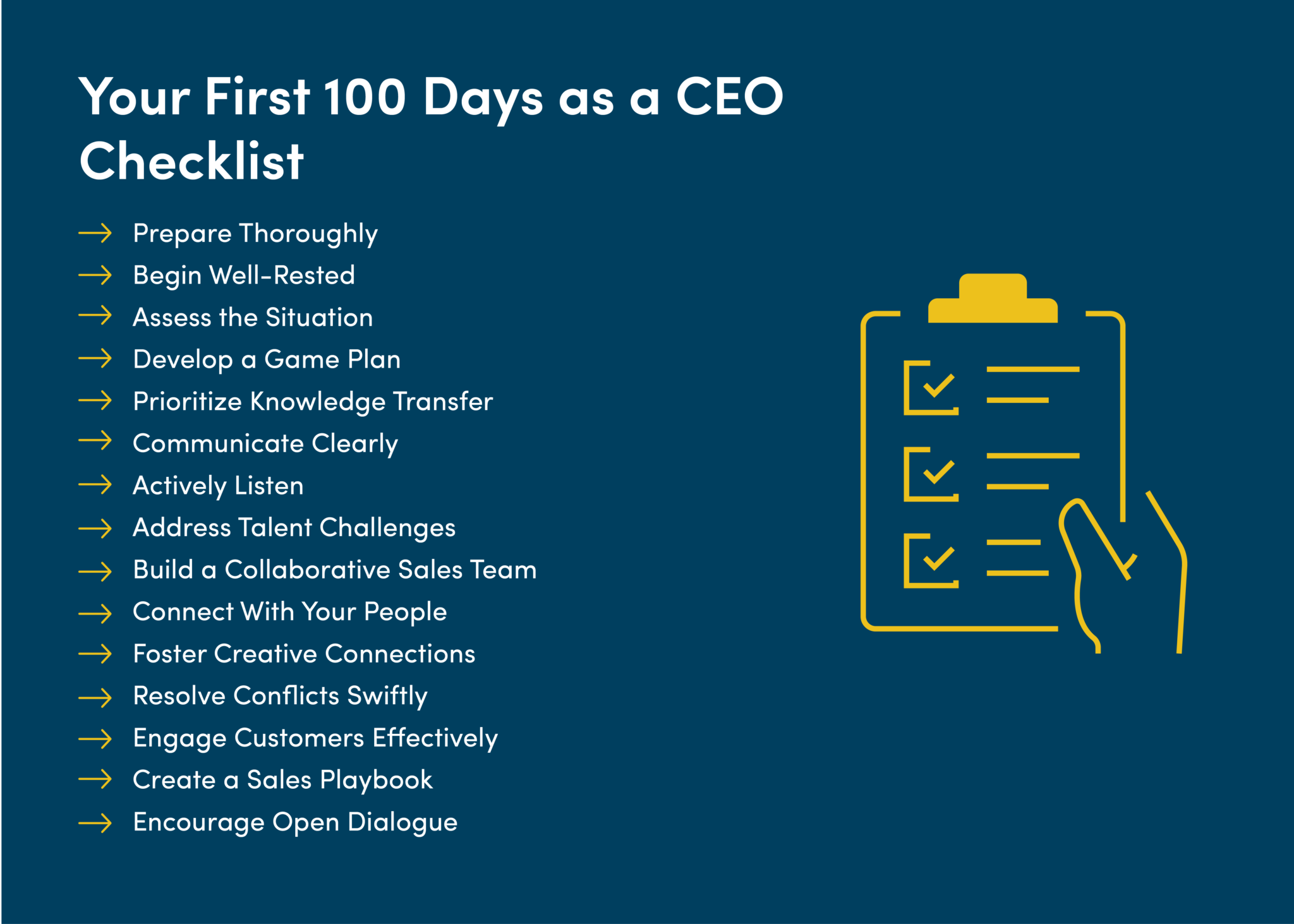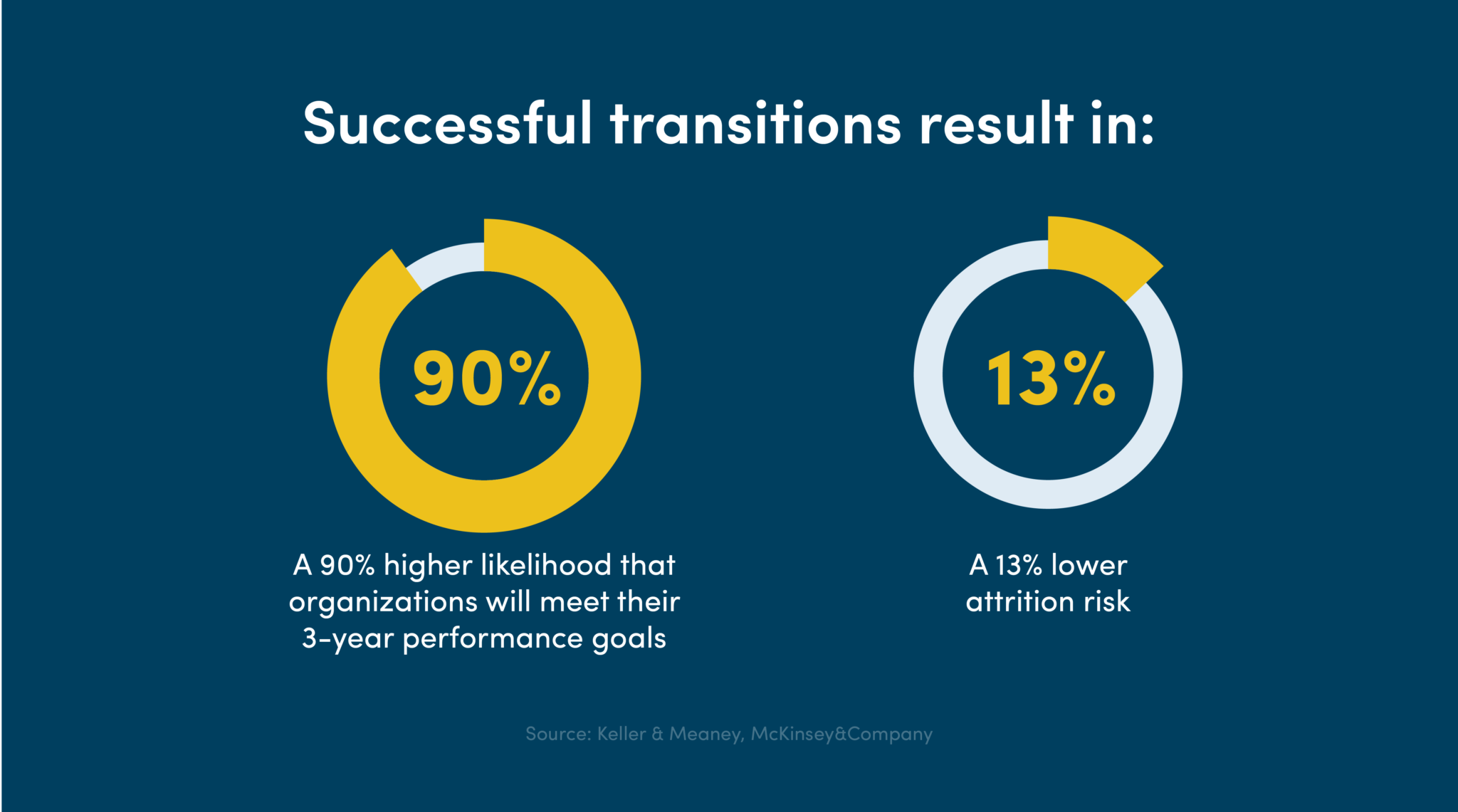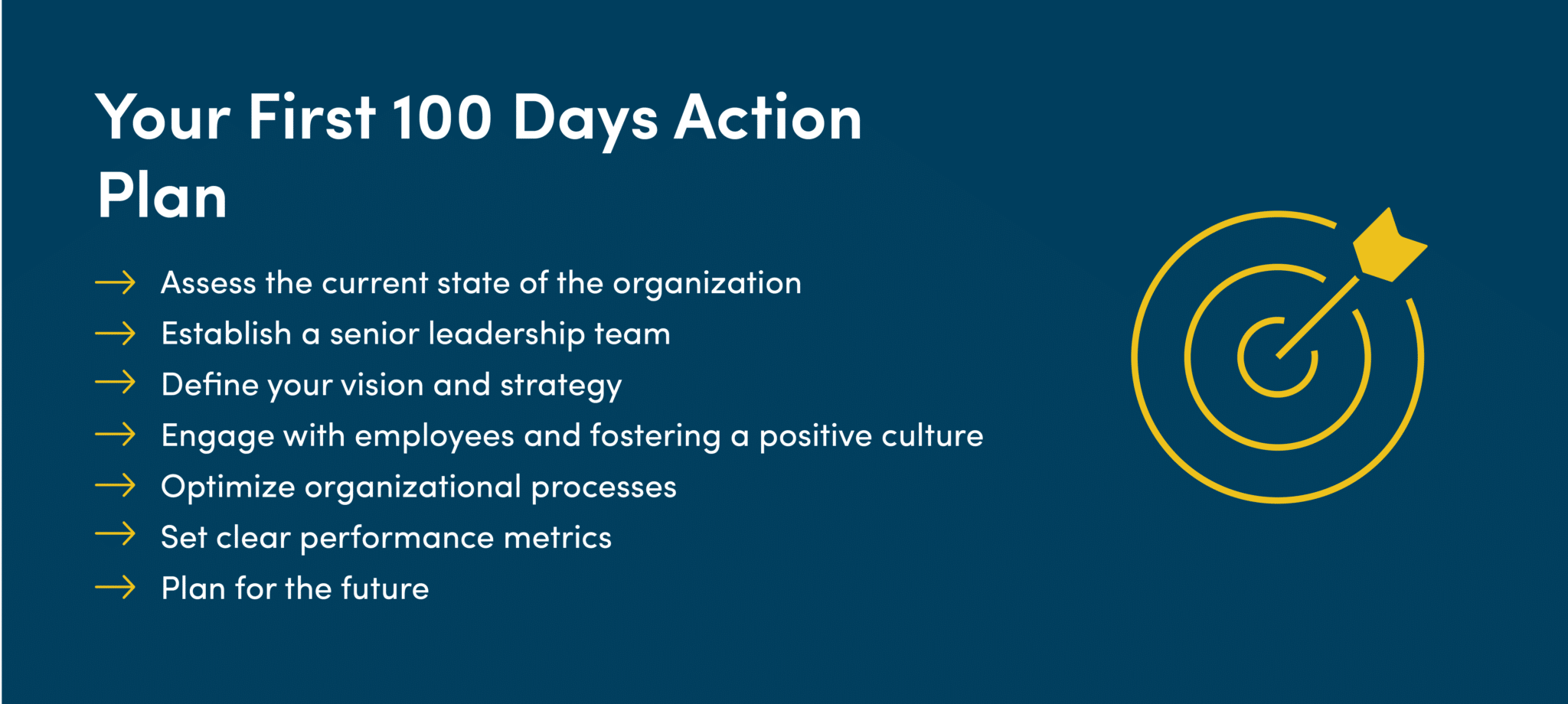A CEO’s First 100 Days: What Should a New CEO Do First?

As a new CEO, you never get a second chance to make a first impression. Those first 100 days on the job are crucial, as they set the tone for your tenure and potentially impact your effectiveness as a leader. For a CEO, the first 100 days can make or break the future success of your entire company.
But what should you do to make a strong start? Within those first 100 days as a CEO, focus on honing in on your leadership skills and taking a thoughtful approach to integrating with a new company. Implementing effective business strategies and techniques will help you create an impactful new CEO 100 day plan.
For insight and advice, we turned to three seasoned executives from the Vistage community: Carol Steinberg, President of CIK Consulting; Robert Powell, CEO of Invictus Leadership Group; and Charles Bernard, CEO of Criteria for Success. Together, they offered these 15 tips for CEOs in their first 100 days, spanning leadership qualities, strategic mindsets, and more.
- Prepare Thoroughly
- Begin Well-Rested
- Assess the Situation
- Develop a Game Plan
- Prioritize Knowledge Transfer
- Communicate Clearly
- Actively Listen
- Address Talent Challenges
- Build a Collaborative Sales Team
- Connect With Your People
- Foster Creative Connections
- Resolve Conflicts Swiftly
- Engage Customers Effectively
- Create a Sales Playbook
- Encourage Open Dialogue

1. Prepare Thoroughly
What should a new CEO do first? Before your official start date as a new CEO, spend time conducting in-depth research about your competitive environment, says Steinberg. Consider some of the following:
- Look closely at what your competitors are doing and how they’ve been successful.
- Study the economic trends that could impact your business in the near term.
- Start thinking ahead, considering how you might use advancements such as Artificial Intelligence or the Internet of Things for competitive gains in the future.
2. Begin Well-Rested
When deciding what a new CEO should do first, it’s important not to overlook the need for self-care. Starting a new role and becoming a new leader are stressful positions. To deal with the demands of leading a company, you have to come to the job feeling rested. So, take a long vacation before you start. “Really get away — for at least a week — so that you won’t get exhausted in the new role,” says Powell. “I’ve seen it before: Someone immediately jumped from one job into another, and they never had time to take a break. They were ineffective.”
3. Assess the Situation
Good decision-making skills will keep your business on track. A new CEO 100 day plan should take the current situation into consideration to provide context for future business decisions. Is the business you’re leading financially stable or in financial distress? If it’s the latter, have a good understanding of the issues before going in, along with a realistic plan for how you’re going to handle them. “If the house is burning, you’ll need to make quick decisions around what changes need to take place and what expenses have to be cut,” says Powell. For example, you might need to realign product mixes or realign the entire organization in your first 100 days.
4. Develop a Game Plan
As a CEO, you’re the person responsible for setting a vision and getting everyone else on board. Establishing this vision in your first 100 days will help you stay focused on the issues that matter most, says Steinberg. “It’s really important to lay out your game plan so you don’t get distracted, fall down rabbit holes, chase after tangents, or ignore the things that you should really be looking at,” she explains.

Creating a game plan can help ensure a smooth transition, which is crucial to your success. In fact, a successful transition results in a 90% higher likelihood that organizations will meet their 3-year performance goals and result in a 13% lower attrition risk. It will also help you manage the wide array of challenges you’ll inherit as a new CEO, whether you’re replacing someone who retired or someone who was let go.
5. Prioritize Knowledge Transfer
As a CEO, you need to give people the context, permission, and space to transfer knowledge to other people in the company, says Bernard. Otherwise, you’ll inevitably become a bottleneck for your direct reports. In leadership team meetings, he says, encourage your top salespeople to share their “secret sauce” with their colleagues. Better yet, create projects that organically involve knowledge transfers, such as building a sales playbook for the company. During your first 100 days as CEO, prioritize knowledge-sharing, open communication, and cross-functional meetings.
6. Communicate Clearly
Within your first month on the job, have a full company meeting and outline your action plan. Communicate what you intend to do over the next one to two quarters. Be open and transparent with your plans. Otherwise, you’ll leave people guessing or forming opinions based on something they’ve heard, which may or may not be accurate. “Give people the unvarnished truth,” says Powell. “A lot of times CEOs think they need to put their spin on things, but that’s not necessary — because people often already know the truth.”
7. Actively Listen
When CEOs are eager to establish themselves as leaders, they may focus on issues in the company where they can bring the most expertise. Resist this urge and instead “be a sponge,” says Steinberg. “Listen and let people know that you’re listening and that their input is important to how you formulate your business strategy, your thoughts, and your priorities. Don’t come in there saying, ‘I’ve done this before and know exactly what I’m going to do.’” Make it a priority to listen actively over speaking. Active listening not only helps your staff feel heard but also provides you the opportunity to learn more about the company in your first 100 days as CEO.
8. Address Talent Challenges
The COVID-19 crisis has revealed a lot about talent: how important it is, how expensive it is, how harmful toxic employees can be, and how challenging it is to lose your best people. For these reasons, a new CEO needs to get directly involved in talent issues. As a first step, Steinberg recommends reading performance reviews or assessments to get a good sense of your talent pool. She warns against the practice of dismissing existing teams so you can bring in your own people. “This is dangerous — it makes the rest of your employees think, ‘Maybe I’m next,’” she says. “You have to understand your talent before you try to clean the slate.”
9. Build a Collaborative Sales Team
This team should work across sales, marketing, operations, finance, human resources, and executive leadership, says Bernard. “The new paradigm for a new CEO is sales is no longer a separate function,” he says. “If your focus is growing the business — which I can’t imagine it wouldn’t be — then you must form a sales growth team.” By focusing on a collaborative approach to sales, you ensure your business teams are equipped with the tools and knowledge needed to operate efficiently. As a CEO in the first 100 days, assess the current structure of sales, marketing, and operations teams to discover how you can improve the setup for a more streamlined approach.
10. Connect With Your People
It’s a given that you’ll need to study your company’s operations, processes, KPIs, trends, and economic influences. But it’s important to know your stakeholders just as well, whether that’s employees and shareholders or vendors and customers. Understand what people are doing at all levels; visit different sites and facilities and have frank and strategic conversations. “Don’t just sit in your corner office listening to the four people who report to you,” says Steinberg. “Really get out there. People need to see that you mean business.”
11. Foster Creative Connections
If you’re leading a company with a remote workforce — as many CEOs are during COVID-19 — you’ll need to use nontraditional methods to connect with your employees. Make it an objective way to connect with them. Steinberg suggests treating employees with GrubHub gift cards or scheduling interactive activities like cooking lessons or live comedy shows on Zoom. “Just do things to signal, ‘I understand, I care, I sympathize, and maybe this will cheer you up today,’” she says. “Little things like that mean an awful lot, especially when we can’t pat people on the back anymore or shake their hands in the hallway.”
12. Resolve Conflicts Swiftly
Leadership accountability is key when it comes to optimizing your company’s performance. You need to resolve two types of conflict right away: those caused by unfilled expectations and those caused by withheld communications. “Oftentimes, those go together,” says Bernard. Uncovering these conflicts will require asking thoughtful questions during one-to-one meetings as well as team meetings. “Don’t say, ‘Do you have any conflicts?’ Because people are going to say, ‘No, I’m all good – no conflicts.’” Be open to hearing whatever issues come your way, he says, as it will help you build trust with your teams and lead a stronger organization.
13. Engage Customers Effectively
Don’t wait until there’s a problem to talk with your customers. Powell recommends reaching out proactively to ask three simple questions:
- What should we start doing?
- What should we stop doing?
- What should we continue doing?
“Customers are going to be your best source,” says Powell, “because they can tell you about the quality of your product, your delivery time, and ideas they may have that can provide you with a strategic advantage.” Having this conversation will help you build better relationships with your customers and can even reveal new opportunities for strategic partnerships, he adds. If you’re unsure about your role in interacting with customers, don’t be shy. Your role as a CEO is to guide the company to success. Customer satisfaction is a core element of business growth, meaning your role as a CEO should involve promoting positive customer interactions.
14. Create a Sales Playbook
Within the first 100 days as CEO, figure out if the company has a sales playbook and how it can be improved. If your company’s sales activities all funnel through your vice president of sales, you have to develop a cross-functional sales strategy through a playbook, says Bernard. This playbook should provide everything from email templates to value propositions to success stories. Get everyone to collaborate on it: Your finance team, for example, should weigh in on pricing, profitability, compensation, incentive plans, management by objectives, and bonuses, and your HR team should weigh in on processes for onboarding, skills development, and ramping up new hires. “Today, with COVID-19, there are a lot of fragmented components to the organization,” says Bernard. “As a CEO, you need to establish common agreements, common expectations, and common processes.”
15. Encourage Open Dialogue
Executive transitions can be difficult for all employees in an organization. To pave the way for a CEO transition, Powell recommends scheduling a special type of interactive meeting with all employees: The meeting starts with the new CEO briefly introducing themselves to everyone in the organization. Next, the CEO leaves the room so that employees can come up with a list of questions they’d like the CEO to answer. A facilitator records the questions but keeps the employees’ identities anonymous. Then, the CEO returns to the room and answers the questions as honestly as possible. “Inevitably, what happens through this process is a dialogue begins to form between the individuals in the room and the new leader,” Powell explains. “It melts the ice because employees are allowed to ask the questions they’re wondering, and it opens up lines of communication.”
First 100 Days as a CEO FAQs
What should a CEO do on the first day?
First impressions matter. On your first day as a new CEO:
- Contact board members
- Interact with as many staff–across levels and departments– as you can
- Set aside time to introduce yourself to key stakeholders
- Ask questions
- Demonstrate interest in understanding roles and challenges
By actively engaging with your new team, you demonstrate the type of leader you want to be. Avoid coming off as distant or uninterested by seeking opportunities to listen to staff and observe business in action. Introducing yourself as a hands-on CEO will set the tone for your entire tenure with the company.
What should be included in your first 100 days action plan?
Now that you’re in charge, you’ll need a plan that can be communicated with senior leaders and employees at all levels. As you draft your plan, consider including:
- Your company’s strengths and opportunities, as well as the current state of the marketplace
- Your main speaking points for each stakeholder
- Your action and communication plans
- Your goals
- Your metrics for measuring success

A well-planned action plan provides structure and purpose to your first 100 days as a CEO. Create a new CEO 100 day plan to guide your decisions and priorities. This will ensure you make use of all your time and actively participate in the business from the get-go.
What are mistakes new CEOs make?
When it comes to the question “What should a new CEO do first?” new CEOs encounter several challenges. Some of the most common mistakes CEOs make in the first 100 days include failing to listen, overestimating their abilities, neglecting culture and team dynamics, and not setting clear priorities.
New CEO 100 day plans often include strong visions and ideas but can make it difficult to listen to and understand employee insights and concerns. Similarly, new CEOs may underestimate the complexity of the role and overestimate their ability to quickly make significant changes.
Ignoring existing corporate culture can lead to resistance and a lack of support from employees. Avoid making these mistakes by setting clear priorities, focusing on alignment, and striving for a smooth transition. Other common mistakes new CEOs make in the first 100 days include:
- Moving too quickly or too slowly
- Ignoring the importance of communication
- Not managing their time effectively
- Avoiding tough decisions
- Being overly insular
- Failing to remain agile and adaptable
- Not delegating effectively
It’s important to keep in mind that to be your best, you have to feel your best. Don’t neglect self-care, especially in those tricky first 100 days as a new CEO. While the first months can be taxing and stressful, it’s important to practice self care, such as getting enough sleep, exercising regularly, proper nutrition, and fostering relationships. This will help you be the best leader possible.
How can you prepare for your first 100 days as a CEO?
Preparing for your first 100 days as a new CEO is crucial to your success in the role. Here’s a step-by-step guide on how to prepare effectively:
- Join a peer advisory group: Look for peer advisory groups like Vistage or other local CEO networks to unlock valuable insights and support. The main benefits of peer advisory groups include networking, mentorship, and learning from shared experiences. In your early days as a new CEO, mentorship is invaluable to your success.
- Familiarize yourself with the company: Study the industry your company operates in by analyzing market trends, competitors, and potential disruptions. The more you know about your industry and your specific company, the better equipped you’ll be to handle an array of challenges. Dive deep into the company’s financials and performance reports to identify areas of strength and weaknesses.
- Strengthen your communication skills: To communicate effectively, you’ll need to craft a clear and cohesive vision for the company. Make it concise, inspiring, and easy to understand. Develop a structured communication plan so you’re prepared to disseminate your vision to stakeholders, employees, investors, and the board. You can also practice public speaking to improve your ability to convey messages persuasively.
How can you measure success during your first 100 days?
There are several questions leaders should ask themselves during their first 100 days to effectively measure success. One of the most important questions is how you will measure success during your first 100 days as a CEO. Measuring success is essential to understand how well you’ve transitioned into the role and whether you’re on the right track. Here’s how to measure success effectively:
- Set clear, measurable goals
- Define key performance indicators (KPIs) that align with your strategic priorities
- Ensure that your goals are quantifiable
- Regularly review progress towards your goals (weekly or monthly basis)
- If you notice you’re not on track to meet your goals, adjust as needed
- Seek feedback through employee surveys, one-on-one meetings, or focus groups
- Engage with key stakeholders and senior leadership to get input on the direction of the company
Compare the results to your initial expectations when you set objectives at the beginning of your first 100 days as a CEO. This will give you a better indication of the progress you’ve made and guide how you adjust and plan the next phase. Measuring success is an ongoing process that helps you adapt your leadership approach for sustained success.
Wrapping Up: A CEO’s First 100 Days
The first 100 days in your role as a new CEO are critical to your long-term success in the position. Spend this time preparing, researching and listening to differing perspectives on the business you lead to develop trust with key stakeholders and maximize the impact of your role.
By paying attention to the needs of your employees, stakeholders, and customers, you’ll become better equipped to navigate the dynamic role of a new CEO. Keep in mind that there is no one-size-fits-all solution to taking over as CEO. Remain flexible and adapt to changes in the company and market as they come.

